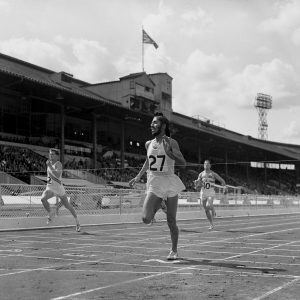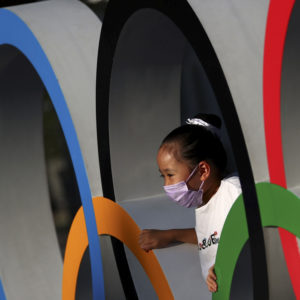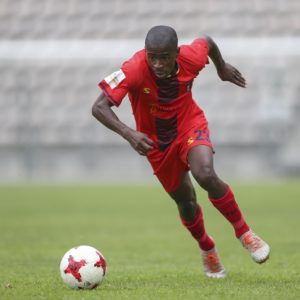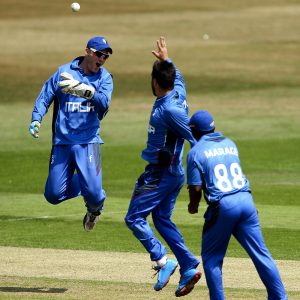How Italy got ahead in the sprints
Lamont Marcell Jacobs is an unlikely star to take over from Usain Bolt. But those who have been following his and Italy’s athletics progress weren’t surprised that they won Olympic gold.
Author:
18 October 2021

“The postponement of the Olympics was a great stroke of luck for us,” says Paolo Camossi, the coach of the new 100m king and European record holder Lamont Marcell Jacobs.
“When they told us about it, we were training. We stopped and thought thank goodness, because in 2020 we wouldn’t have been ready technically and mentally.” Jacobs had won the gold in the 60m at the European Indoor Championships in Poland in March, “but even at the Olympics we never thought about winning gold. We wanted to run a great final taking advantage of the mistakes of others for a medal, but not for the gold.
“We were afraid to think about it. But after the semifinal we understood that he was like them, that whoever made fewer mistakes would win. After [Usain] Bolt, there was no longer a super favourite.”
Related article:
The shortcomings of opponents were certainly crucial, but the causes that led to one of the most surprising sporting results of the northern hemisphere summer are many – and credit goes to Jacobs and his team.
It started with a choice that proved successful. That is, switching from long jump to the 100m event. This choice should have been momentary, considering that Camossi is a former triple jumper who had never been a sprint coach.
“After a bad mishap at the 2019 European Championships in Glasgow, where we went out in the qualifying heat, we realised that we couldn’t achieve good results,” says Camossi. “So we decided to try the sprint in the second part of the season.”
New event, new approach
It wasn’t a random change. At the time, Jacobs was among the fastest long jumpers and was running the 100m in 10.09s.
“Jacobs could have run under 10 seconds as early as 2019, but lacked the ability to combine his qualities in the best possible way,” says Camossi. The potential was already there and while working on the sprint, excellent results came out, such as the great anchor he raced in the 4x100m relay final at the Yokohama World Championships, where he overtook the then 37-year-old but still competitive Justin Gatlin.
“After that, we quit long jump to be able to fully focus on 100m,” says Camossi. “Today, you can’t afford not to specialise in one discipline, because the competition is too strong.”
The 100m is a discipline in which there is no margin for error, unlike in the jumps where the athlete has more attempts at winning. Jacobs used to approach the 100m in three parts: start, acceleration and final sprint. “That’s why, never in any race, he finished without errors until 2021,” says Camossi. “When he started to see them as a single long acceleration, everything changed.”
They began to work on Jacobs’ technique and biomechanics, with which Camossi is obsessed. Now, when Jacobs puts his foot on the ground, he brakes less than his competitors. And great results started to arrive.
At the Bauhaus-Galan international athletics meet in Stockholm on 4 July, Jacobs ran the 100m in 10.05s with 1m of headwind and came second, behind American sprinter Ronnie Baker.
Five days later, Jacobs shone in Monaco at the Herculis EBS stage of the annual Wanda Diamond League, seen by many as a preview of the Tokyo Olympics three weeks later. Jacobs finished third that night, in 9.99s, just behind Baker and South Africa’s Akani Simbine. It was the second time in his career that he’d run the 100m in under 10 seconds, after his 9.95s at the meet in Savona on 13 May. It proved Jacobs could compete with the best sprinters in the world.
A head game
“This year’s goal was to increase the frequencies, while leaving the width of the stride unchanged, indeed tightening it,” says Camossi. “We have reached 4.57 movements per second and 45 [foot] supports.”
Put simply, this is the reason Jacobs ran a 9.80s and took gold in the Olympic final. “The future goal is to free the stride even more and further raise the frequencies.”
Taking these results into account, Franco Bragagna, the athletics commentator for RAI, Italy’s national public broadcaster, recognises that Jacobs’ win wasn’t a complete revelation. “I imagined he could make it to the final if he defeated his fears,” Bragagna says. “Then I gradually realised that he could be the star. He was the most fit. It was exciting, because since I became the main athletics commentator in 1995, there had never been similar results for Italy and I wasn’t used to it.”
Related article:
Another turning point for Jacobs, possibly the most decisive, was relying on mental coach Nicoletta Romanazzi. He embarked on a mental growth path with her in September 2020, at the suggestion of his manager. When Jacobs arrived at the Olympic stadium, he greeted everyone. He was serene. “When the British Zharnel Hughes made the false start, Jacobs remained lucid and didn’t follow him,” says Camossi. “He told me that he smiled, looked at his rivals and told himself that they had to run after him because he was going to win. He wanted to enjoy and have fun.”
Bragagna agrees. “This [peace of mind] was the last step he needed to take,” he says. “Jacobs’ big limit was the inability to perform well at big events. Moreover, he suffered from the comparison with Filippo Tortu.”
Fruits of labour
Tortu was the first Italian sprinter to stop the timer under 10 seconds. His 9.99s at the international meet in Madrid in 2018 broke legendary Pietro Mennea’s record of 10.01s, achieved in Mexico City 39 years earlier. Tortu’s record brought great enthusiasm and fired up Italian athletics.
Tortu is one of the protagonists of the other unexpected Italian sprint success at the Olympics, the gold medal that the country’s 4x100m relay team won. Jacobs, Fausto Desalu and Lorenzo Patta, who joined the relay just before the start of the Olympics, make up the rest of the team.
“Our growth started at least five years ago,” says Filippo Di Mulo, the technical director of Italy’s sprint national team. “This is my third term and now the fruits of our work are beginning to be seen.”
Related article:
Di Mulo says their training programme looks further than just today’s result – it “looks to a more gradual maturation of the athlete and to avoid early specialisation”.
Unlike Jacobs, Di Mulo says the Italian relay team was ready in 2020, at least technically. “Italy has been more organised during the worst months of the pandemic. We continued to work almost non-stop and even when we were forced to stay at home, we provided everybody with educational webinars and forced the athletes not to stop training. Even if there were no important events … we urged them to train and compete, because in the meantime other nations were skipping a lot of activities.”
Bragagna says the Olympics’ postponement to 2021 was fundamental as it allowed Italy’s athletes to grow while the best sprinters in the world were losing their edge, especially America’s Trayvon Bromell. “Jacobs has improved a lot in the start. Patta, who was injured, was promising but not that strong. Desalu, who had to race the first anchor, was moved to third just before the Olympics.”
Training methods
In Tokyo, Italy broke four national records in the sprint and was among the few nations with five male and female relay teams. “We had five teams also at the IAAF World Relays in Yokohama and at the World Athletics Championships in Doha in 2019,” says Di Mulo.
“In the last five years, I have been able to work with qualified human capital, which is fundamental. There are excellent talents behind the champions we have seen in Tokyo. Patta is still under 23. [Edoardo] Scotti and [Matteo] Melluzzo have considerable potential. Other junior sprinters and students are emerging. We are growing well and are starting a high-level and long-lasting cycle.”
Di Mulo adds a useful element to measure quality. There is an index of ability that calculates how many seconds a relay subtracts from the individual times added up. “The sum of our individual times [40.44s] was such that we could aspire to sixth or seventh place,” he says. “So our win stems from the maniacal search for perfection in the baton exchanges. In the final, we have subtracted around three seconds [2.94s] from the sum of our individual times.
Related article:
“I hope that these wins will bring more athletes to the Italian athletics federation. As for the sprint, I hope that we understand that we must also aim for the relay races, because running the relay doesn’t mean giving up the individual competition. You just need to sacrifice a little more, but satisfaction can be huge.”
Bragagna agrees that these Olympic medals promote the Italian sprint hugely, because now they are talking about nothing else. “It was a huge surprise and there is the hope that many will start athletics after this summer. I see great enthusiasm and a good future, because we have never seen so many talents altogether.”
Italy’s national sprint team is experiencing such a positive moment precisely because of innovations in the field of training, says Camossi. “In the past, important pages of history have been written in Italy from the point of view of results and training methods. This has trained many coaches who then went around analysing how others train and run. The improvements are evident when you see that, apart from winning the gold in the 4x100m relay, there are various junior sprinters who run in around 10.20s, a time once achieved by the best Italian sprinters.”




